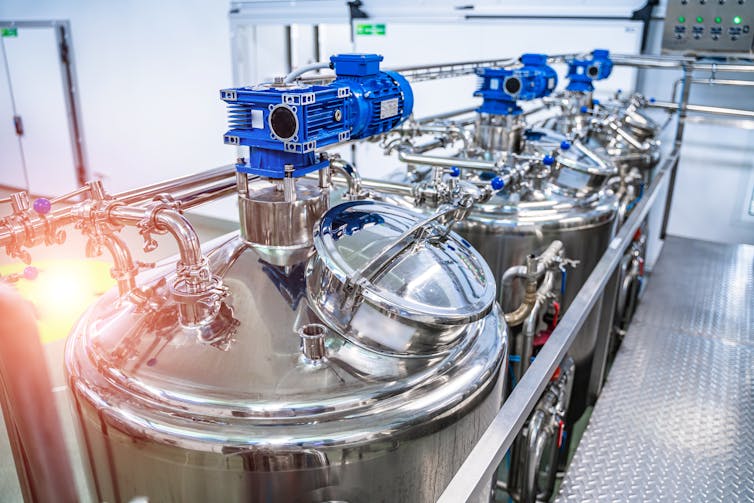Reports that the H5N1 virus has been found in raw and pasteurized milk in the United States have raised questions regarding the safety of H5N1-contaminated milk for human consumption. Although H5N1 influenza usually affects birds, it was recently found in U.S. dairy cows. According to the Public Health Agency of Canada’s April 26 update, no cases have been reported in Canada yet.
To answer questions about the safety of drinking milk contaminated with the H5N1 virus, it is important to understand some basic biology of H5N1 and other related viruses.
Table of Contents
Influenza virus structure
There are four types (A, B, C and D) of influenza viruses. Seasonal flu in humans is caused by types A and B.
Subtypes of influenza A virus are named based on two proteins found on the surface of the virus: hemagglutinin (H) and neuraminidase (N). There are 18 different hemagglutinin subtypes and 11 different neuraminidase subtypes. That means H5N1 is identified as having H subtype 5 and N subtype 1.
Influenza is an enveloped virus, meaning that it takes its outer layer from the host cell that it’s infecting, enveloping itself. Then the H and N proteins are inserted into that outer layer.
Many studies have shown that enveloped viruses are not stable outside of the animal host, in contrast to non-enveloped viruses (such as foot and mouth disease virus, which infects cattle), which are much more stable.
The lack of stability of the H5N1 virus is an important piece of information in trying to understand if milk (and other foods) that may contain the virus are safe to consume. For example, influenza viruses are unstable at high temperatures, and sensitive to low pH (acidity). Based on this information, and knowing how pasteurization is performed, we can come up with reasonable conclusions about the safety of pasteurized milk.
Does pasteurization kill the H5N1 influenza virus?
Pasteurization was developed in the 1800s, and has become the main method to effectively reduce the presence of infectious microorganisms in milk. Pasteurization typically involves heating milk to 71.7 Celsius (162F) for 15 seconds before cooling, or heating it to 63C (145F) for 30 minutes before cooling.
On the question of safety of milk for human consumption, there isn’t much data specifically about how well pasteurization inactivates H5N1 in milk. However, there are studies on heat inactivation of H5N1 in other foods.

(Shutterstock)
For example, one such study analyzed the inactivation of H5N1 in foods including chicken, homogenized whole egg, egg yolk and fat-free egg. It found that the D value (decimal reduction time: the time required at a specific temperature to inactivate 90 per cent of the virus) at 60C was less than one minute in each of these foods.
Another study found that in chicken at 61C, the D value was 33 seconds, and at 70C, the D value was 0.28 seconds. It’s important to note that the temperatures used in the above studies are all lower than what is used during pasteurization of milk.
Considering that milk pasteurized at 71.7C is held for 15 seconds and milk pasteurized at 63C is held for 30 minutes before cooling, there is very good evidence from other foods that the process will inactivate the H5N1 virus.
What is known about the risks of H5N1 in milk?
It is important to discuss the recent finding of viral remnants of H5N1 in dairy milk within the context of the above information. The United States Food and Drug Administration reported that approximately 20 per cent of retail milk samples that they tested were positive for H5N1, with a higher percentage of positive test results coming from milk in areas with infected cattle herds.
The method used to test the milk, called quantitative polymerase chain reaction (qPCR), detects fragments of viral nucleic acid, which may represent live or inactivated virus. It cannot differentiate between those, and virus that is effectively inactivated (killed) by pasteurization would still be detectable.
That means that while the test results demonstrate that H5N1 can contaminate milk, the tests cannot provide information about the risk of consuming H5N1-contaminated milk.
Another study that has garnered recent attention showed incomplete inactivation of foot and mouth disease virus in milk after pasteurization. However, this virus is non-enveloped, and is much more stable than enveloped viruses such as H5N1. So, this study cannot be used as an indication that influenza virus would not be inactivated by pasteurization.
Beyond pasteurization, there are other layers of protection when it comes to the risk of milk-borne H5N1 transmission. For example, studies have shown that influenza viruses are rapidly inactivated at pH values below five.
The pH of human stomach fluid ranges anywhere from one to 3.5. Therefore, even if low concentrations of infectious H5N1 virus particles manage to survive pasteurization, which may be potentially possible if very high numbers were initially present in raw milk, they would likely be quickly inactivated during passage through the stomach. This means that the combination of pasteurization and stomach acidity provides a double layer of protection against infection.
The potential inactivation of H5N1 by stomach acidity is not, by itself, enough to ensure the safety of milk, which has direct ramifications with respect to the safety of consuming H5N1-contaminated raw (unpasteurized) milk. Multiple food safety authorities around the world are unanimous that there are clear links between drinking raw milk and human illness associated with the presence of pathogens. The consumption of raw milk is therefore strongly discouraged.
The collective data provides strong evidence that the risk associated with consumption of pastuerized H5N1 contaminated milk is minimal.
![]()
Lawrence Goodridge receives funding from the province of Ontario Ministry of the Environment, Conservation and Parks.
J Scott Weese does not work for, consult, own shares in or receive funding from any company or organisation that would benefit from this article, and has disclosed no relevant affiliations beyond their academic appointment.

























